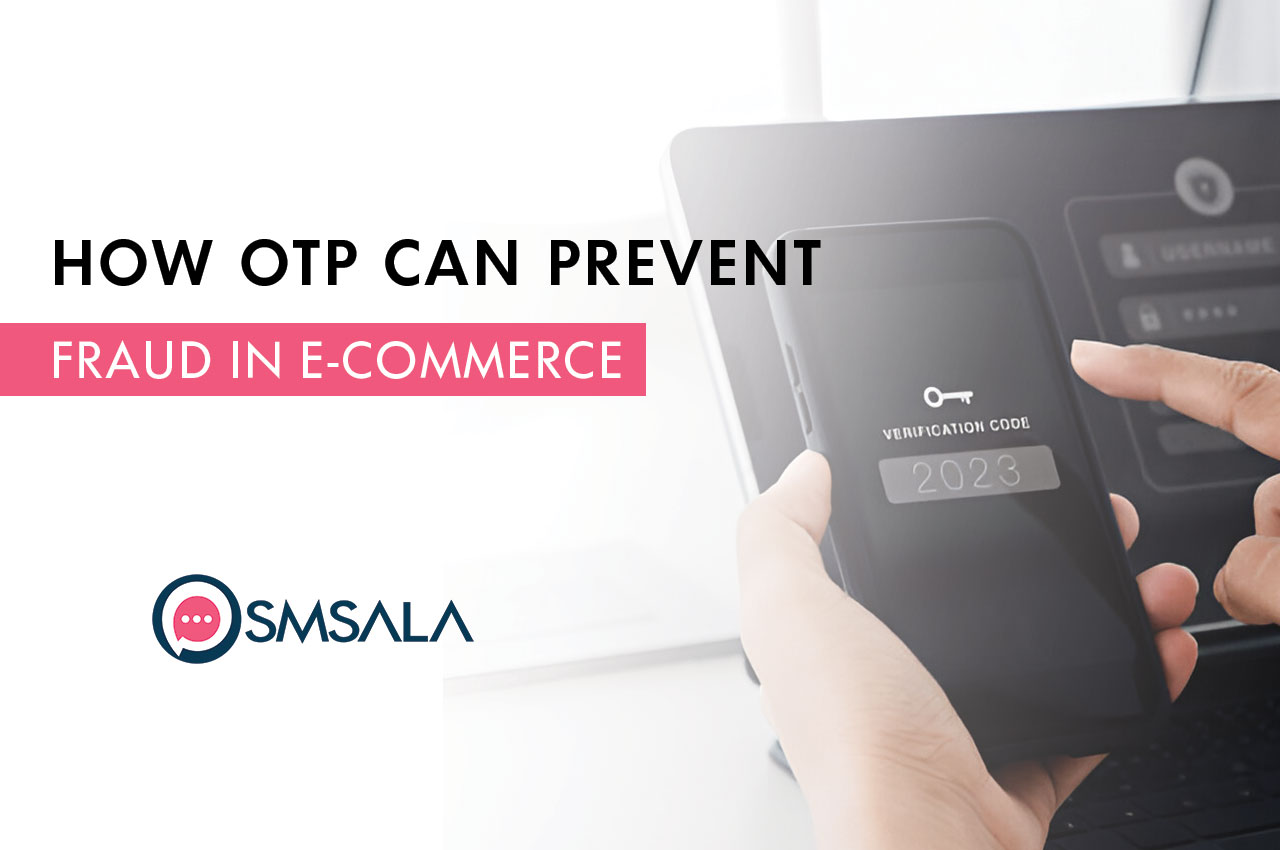As the e-commerce sector continues to grow, so do the risks associated with online fraud. With more consumers opting for the convenience of online shopping, businesses face the challenge of securing transactions while providing a seamless customer experience. Fraudsters are becoming increasingly sophisticated, exploiting vulnerabilities in online payment systems, customer accounts, and transactional processes. In this context, OTP (One-Time Password) technology has emerged as a highly effective tool to combat fraud and safeguard sensitive customer information.

OTP adds an extra layer of security to online transactions and user authentication by requiring users to verify their identity through a temporary password sent via SMS, email, or an authentication app. By ensuring that only authorized individuals can access accounts or approve transactions, OTP plays a critical role in preventing fraud and securing e-commerce platforms.
This article delves into how OTP can help prevent fraud in e-commerce, why businesses should implement it, and the best practices for utilizing OTP effectively.
Read More: Top 5 OTP Service Providers
The Growing Threat of E-commerce Fraud
The rise of e-commerce has transformed the retail landscape, enabling consumers to shop from the comfort of their homes. However, as online transactions have surged, so has the number of fraudulent activities. From identity theft to unauthorized transactions and phishing scams, e-commerce fraud presents significant risks for both businesses and consumers.
According to various reports, e-commerce fraud is expected to cost businesses billions of dollars annually. Common types of fraud in the e-commerce sector include:
- Account Takeover (ATO): Fraudsters gain unauthorized access to a customer’s account by stealing login credentials. They then make purchases using the compromised account, leaving the legitimate user unaware until it’s too late.
- Payment Fraud: This occurs when a fraudster uses stolen credit card details or fake payment information to make purchases, leading to chargebacks for the business.
- Phishing and Social Engineering: Fraudsters trick customers into sharing sensitive information, such as login credentials or credit card numbers, by pretending to be a trusted entity.
- Card Not Present (CNP) Fraud: Since e-commerce transactions are often processed without the physical card present, it becomes easier for fraudsters to misuse stolen card information to complete purchases.
For e-commerce businesses, the cost of fraud is not only financial. It also damages brand reputation, erodes customer trust, and results in the loss of loyal customers. As fraud continues to evolve, businesses need to adopt robust security measures that can address these challenges, and OTP has proven to be a powerful solution in this regard.
What Is OTP and How Does It Work?
One-Time Password (OTP) is a unique, temporary code generated for a single transaction or login session. Unlike static passwords, which remain the same until changed by the user, OTPs expire after a short time or after being used once, making them highly secure. OTPs are typically delivered via SMS, email, or through an authentication app.
Here’s how OTP works in a typical e-commerce transaction:
- Customer Action: A customer initiates a sensitive transaction, such as logging into their account, making an online purchase, or changing account details.
- OTP Generation: The e-commerce platform generates a one-time password and sends it to the customer through their preferred communication method (usually SMS or email).
- Customer Authentication: The customer receives the OTP and enters it into the platform to verify their identity.
- Verification: Once the OTP is entered correctly, the platform verifies the customer’s identity, allowing the transaction to proceed.
Because OTPs are short-lived and linked to a specific transaction or session, they provide an additional layer of protection against unauthorized access and fraudulent activities.
How OTP Prevents Fraud in E-commerce
The implementation of OTP in e-commerce platforms significantly reduces the risk of fraudulent activities by strengthening authentication and verifying user identities. Here are several ways OTP can help prevent fraud:
1. Strong Two-Factor Authentication (2FA)
OTP is commonly used as part of Two-Factor Authentication (2FA), which requires users to provide two forms of identification to access an account or complete a transaction. In the case of e-commerce, the first factor is usually the customer’s password, and the second factor is the OTP sent to their mobile phone or email.
Even if a fraudster manages to steal a customer’s password, they won’t be able to complete the transaction without the OTP. This adds a significant hurdle for cybercriminals, ensuring that even compromised passwords don’t result in unauthorized access.
2. Preventing Account Takeovers
Account takeovers (ATOs) are a common form of e-commerce fraud where fraudsters use stolen credentials to log into a customer’s account and make unauthorized purchases. OTP can mitigate this risk by requiring an additional layer of authentication during the login process.
For instance, if a fraudster tries to log into an e-commerce account using stolen credentials, the platform will send an OTP to the legitimate customer’s phone number or email. Without access to the OTP, the fraudster is unable to complete the login process, effectively stopping the ATO attempt in its tracks.
3. Securing Payment Transactions
Payment fraud is a significant concern in e-commerce, especially in Card Not Present (CNP) transactions. Fraudsters often use stolen credit card details to make online purchases, leading to chargebacks and revenue loss for businesses.
Implementing OTP during the payment process provides an additional layer of security. After entering their payment details, the customer receives an OTP that they must enter to confirm the transaction. This ensures that even if a fraudster has access to stolen payment information, they cannot complete the purchase without the OTP.
4. Reducing Phishing Risks
Phishing attacks are a common tactic used by fraudsters to trick customers into revealing their login credentials or payment information. By pretending to be a legitimate entity, fraudsters lure customers into sharing sensitive data, which they then use to commit fraud.
OTP can help reduce the effectiveness of phishing attacks by acting as a second layer of defense. Even if a customer falls for a phishing attempt and shares their login credentials, the fraudster would still need the OTP sent to the customer’s phone or email to access the account. Since OTPs are temporary and tied to specific transactions, they limit the window of opportunity for fraudsters to commit fraud.
5. Verifying Account Changes
E-commerce platforms often allow customers to update their account information, such as changing their password, email address, or delivery address. Fraudsters may attempt to change account details to divert orders or gain access to sensitive information.
By requiring OTP verification for account changes, e-commerce businesses can ensure that only the legitimate account holder can make these updates. For example, if a fraudster attempts to change the delivery address on an account, the platform can send an OTP to the customer’s registered phone number for verification. Without the correct OTP, the fraudster is unable to make the change, preventing unauthorized access to the account.
Benefits of Implementing OTP in E-commerce
Beyond fraud prevention, OTP offers several additional benefits for e-commerce businesses and customers alike. Here are some key advantages:
1. Enhanced Security
The primary benefit of OTP is enhanced security. By adding an extra layer of authentication, businesses can reduce the risk of unauthorized access, account takeovers, and fraudulent transactions. OTP ensures that even if a customer’s login credentials or payment details are compromised, fraudsters cannot complete the transaction without the one-time code.
2. Improved Customer Trust
E-commerce businesses that prioritize security are more likely to gain the trust of their customers. By implementing OTP, businesses demonstrate a commitment to protecting their customers’ personal and financial information. Customers are more likely to shop with brands that take security seriously, knowing that their accounts and transactions are protected by advanced authentication methods.
3. Compliance with Regulatory Requirements
In many countries, e-commerce businesses are required to comply with regulatory standards that mandate strong customer authentication methods. For example, Strong Customer Authentication (SCA) is a requirement of the European Union’s Revised Payment Services Directive (PSD2), which mandates the use of two-factor authentication for online transactions.
By implementing OTP as part of their 2FA process, businesses can ensure compliance with these regulations, avoiding potential penalties and ensuring the safety of their customers’ transactions.
4. Reduced Chargebacks
Chargebacks occur when customers dispute a transaction, often because their payment information was used fraudulently. E-commerce businesses face significant losses from chargebacks, not only in the form of lost revenue but also in chargeback fees and potential damage to their reputation.
By using OTP to verify payments, businesses can reduce the likelihood of fraudulent transactions and minimize chargebacks. This protects the company’s bottom line and helps maintain a positive relationship with payment processors.
5. Seamless User Experience
While OTP adds an additional step to the authentication process, it can still be implemented in a way that provides a seamless user experience. Modern authentication systems allow OTPs to be sent via SMS, email, or authentication apps, giving customers the flexibility to choose their preferred method of receiving the code.
Moreover, businesses can reduce friction by only requiring OTP for high-risk transactions, such as logging in from a new device, changing account information, or making a large purchase. This balances security with convenience, ensuring that customers can shop without unnecessary delays.
Best Practices for Using OTP in E-commerce
To maximize the effectiveness of OTP and ensure a positive customer experience, e-commerce businesses should follow best practices for implementation:
1. Use OTP for High-Risk Transactions
Not every transaction needs OTP verification. To minimize friction, businesses should use OTP for high-risk transactions such as account logins, password resets, payment authorizations, and account changes. This ensures that security is prioritized where it matters most without overwhelming customers with constant OTP requests.
2. Ensure OTP Delivery is Reliable
One of the key challenges with OTP is ensuring that the code is delivered reliably and promptly. Businesses should work with trusted service providers to ensure that OTPs are sent via secure channels like SMS, email, or authentication apps. Delays in OTP delivery can frustrate customers and lead to abandoned transactions, so it’s essential to optimize the delivery process.
3. Provide Multiple OTP Delivery Methods
Offering multiple delivery methods for OTPs (SMS, email, authentication app) gives customers the flexibility to choose the method that works best for them. Some customers may prefer to receive OTPs via SMS, while others may opt for email or an app-based authenticator.
4. Implement Expiration Times
To maintain security, OTPs should have a short expiration time (typically 5 to 10 minutes). This ensures that even if a fraudster gains access to the OTP, it will expire before they can use it for malicious purposes.
5. Educate Customers on OTP Security
E-commerce businesses should take the time to educate their customers on the importance of OTP and how it works. Inform customers to never share their OTP with anyone, even if they receive a message claiming to be from the company. Educating customers helps them recognize phishing attempts and protects them from social engineering attacks.
Conclusion
As the e-commerce industry continues to grow, so do the risks associated with online fraud. Implementing OTP technology can significantly reduce the likelihood of fraud by adding an additional layer of authentication to critical transactions and account activities. From preventing account takeovers to securing payment transactions, OTP ensures that only authorized users can access sensitive information and complete transactions.
In an age where customers demand both convenience and security, OTP strikes the perfect balance by providing enhanced protection without compromising the user experience. By following best practices for OTP implementation, e-commerce businesses can reduce fraud, build trust, and deliver a secure shopping experience for their customers.



